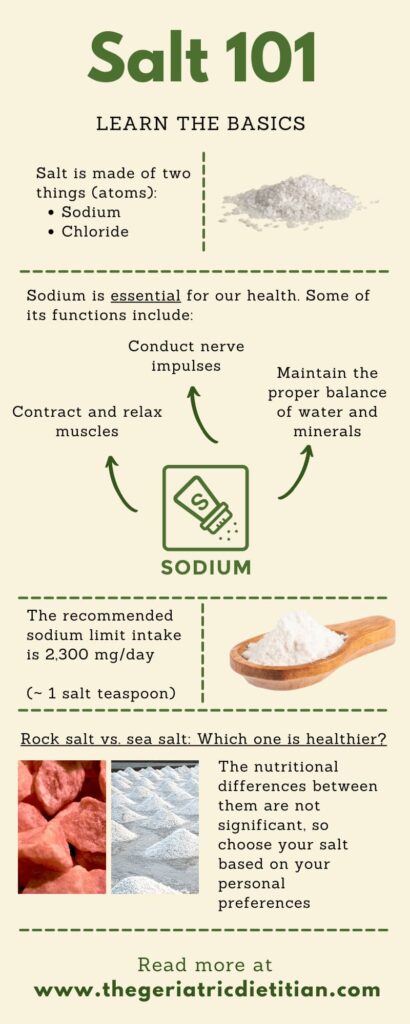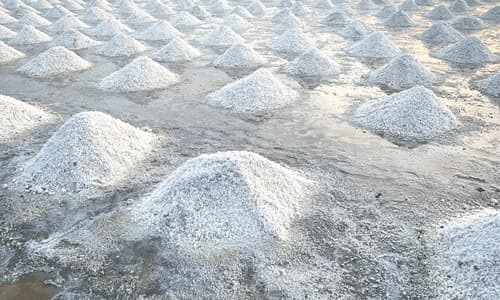Rock Salt vs Sea Salt: What’s the Difference?
“Rock Salt vs Sea Salt: What’s the Difference?” was written by Irene Mejía & edited/reviewed by Aly Bouzek, MS, RDN. Irene is a dietetic intern at Larkin University.
You may have gone to the grocery store and seen dozens of types of salts with different names, colors, and shapes.
Some of these salts include rock salt and sea salt. But have you wondered what’s the actual difference between these two types of salts? For instance, is one healthier than the other?
In this article we will cover:
- What is salt?
- Sodium and our health
- Where do salts come from?
- Rock Salt vs Sea Salt
- Is one salt healthier than others?
- How can I use salts in cooking?
- Salt alternatives
Let’s dive in!
What is Salt, Exactly?
As we will cover in the following sections, each type of salt has a slightly different composition. But overall, salts are made mostly of a molecule called sodium chloride.
As you can see from the name, it means that it is made of two things, sodium and chloride, which are a type of electrolytes your body needs to work correctly. In fact, salt is about 40% sodium and 60% chloride. (1)
Salt and Our Health
You may have heard how we should limit our salt intake because of the effects if we consume too much. Why? And, if salt is made of two electrolytes (sodium and chloride), then why do we only focus on the sodium part?
Let’s find out below!
Sodium vs Chloride
Sodium and chloride work together to maintain adequate fluid levels on the outside of our cells and to help control our blood pressure.
However, changes in sodium concentrations are linked to disorders of water balance, such as hypotension or hypertension, (2) and many other side-effects.
Therefore, in the following sections we may use the words “salt” and “sodium” interchangeably, but keep in mind that salt is made of both sodium and chloride!
Roles of Sodium in Our Body
Salt is necessary for our bodies to function correctly. Some of its roles include: (1)
- Maintain fluid balance
- Transmit nerve impulses
- Contract and relax muscles (like our heart)
Why Is Eating Too Much Sodium a Problem?
Our bodies actually require a small amount of sodium each day to work right. However, eating too much sodium can lead to: (1)
- Increased blood pressure
- Higher risk of heart attack, stroke, and other cardiovascular conditions
- Loss of calcium (which can sometimes be taken away from our bones)
Most adults in the United States exceed their recommended daily limit of sodium.
The 2020-2025 Dietary Guidelines for Americans recommends a sodium limit of 2,300 milligrams (mg) per day (for those 14 years and older). (3)
But the average dietary sodium intake for those 14 years and older is currently more than 3,390 mg per day.
Where Does Dietary Sodium Come From?
Limiting the amount of salt, you add to your foods is indeed a great alternative to limit your sodium intake, but most of the sodium we consume actually comes from sources besides our food!
In fact, only a small amount of dietary sodium is added during cooking and at the table. About 70% of the sodium comes from the meals at restaurants, processed foods, and prepackaged foods. (4)
Sodium is added to these foods to:
- Boost flavor
- Improve look and texture
- Preserve freshness
So, while limiting how much salt you add to your food is recommended, also keep an eye on the rest of the foods you buy at the store or that you eat at restaurants!

Rock Salt vs Sea Salt
Now that we covered the basics about salt, let’s discuss ACTUAL differences between rock salt and sea salt.
Where do Sea Salt and Rock Salt Come From?
Sea Salt

As the name suggests, sea salt comes from seawater. Harvesters create artificial “ponds” made of seawater, usually near the ocean, but they can also be near salty lakes or springs. (5)
These ponds are usually in warm climates that don’t get a lot of rain but have high rates of evaporation. This allows the water to evaporate leaving sea salt behind. (5)
Rock Salt

Meanwhile, rock salts are harvested from rock deposits that were formed by the evaporation of ancient seas millions of years ago. (6)
Rock salts can be mined directly or by adding a solvent such as water. This will dissolve the salt and it will become a solution. Then, the solution is evaporated, leaving the salt behind. (6)
Types of Sea Salt
There are many types of sea salts, and they vary depending on where they’re pulled from and how they’re evaporated.
There are two main methods that result in the following salts: (5)
- Fleur de sel (flower of salt): This salt is collected from the top of salt ponds. It’s white and flaky. It’s used to season foods right before you eat them.
- Sel gris (gray salt) or Celtic salt: This salt comes from the same ponds as fleur de sel but is harvested from the bottom of the ponds. The crystals are gray and look like cubes. It’s produced in greater quantities than fleur de sel.
However, there are specialty salts that have additional processes. Some specialty sea salts include:
- Alaea salt: In Hawaii they add red ‘alaea clay. It has a red color that comes from iron oxide in the clay. (5) Interestingly, this salt can’t be commercially sold because it doesn’t meet the U.S. food grade requirements.
So if you see “‘Alaea salt” in the store, then you’ll know that it’s not made with true ‘alaea clay.
- Smoked salt: Smoked salts are sea salt flakes slowly smoked over a fire.
Types of Rock Salt
Like sea salt, rock salts vary on the type of rock, location, and impurities. Impurities are simply other naturally occurring substances in the rocks that may change the color, shape, or even taste. Some examples include: (5)
- Himalayan pink salt: This is marketed as “Himalayan sea salt”, but it doesn’t come from the sea or the Himalayas! It’s actually harvested in a mine near the Himalayan Mountains base in Pakistan. The pink color is due to iron oxide.
- Kala namak or “black salt”: this salt starts as Himalayan pink salt, but then it is heated and mixed with Indian spices. It smells like rotten eggs because of the sulfur in it.
Wait, But What About Table Salt?
Table salt is actually extracted from rock salt. The rock is heavily processed to remove impurities. Then, it is ground into very fine grains. (1)
Sea Salt vs. Rock Salt – Which One is Healthier?
Many believe that sea salt or even rock salts such as Himalayan salt are healthier because they have not been refined as much.
It’s true that manufacturing strips table salt of other micronutrients, such as magnesium, calcium, and potassium. However, producers add iodine to most table salts to prevent iodine deficiency, which can affect thyroid hormone production.
However, all types of salt are mostly made of sodium chloride, and the trace minerals are present in extremely small quantities. The small amount of trace minerals is not enough to offer significant nutritional benefits. (1)
For example, look at potassium.
Let’s keep in mind that the recommended sodium limit is 2,300 mg per day, around 1 teaspoon of salt. (7)
- Table salt has 2.6 mg of potassium per teaspoon (8)
- Himalayan salt has 14.8 mg of potassium per teaspoon (8)
But the recommended intake of potassium for males aged 19 and older is 3,400 mg and 2,600 mg for females. (9) So, the amount of potassium you can get from salt becomes insignificant.
Therefore, no salt is healthier than the other! If anything, you can choose your salts based on how you want to use it in cooking and what flavor you’d like your food.
How to Use Salts in Cooking?
Salts come in different shapes, sizes, colors, and they have been processed differently. Thus, food may taste completely different depending on which salt you use!
- Finishing salts are added right before eating. These include most sea salts like fleur de sel, sel gris, flaky salts, Himalayan salt crystals, or specialty salts.
- General cooking needs (salting your pasta water, seasoning your vegetables) can be met with table salt or Himalayan salt.

The Bottom Line
The main differences between sea salt and rock salts are in their taste, texture, and processing.
There is no significant difference in nutritional benefits between salts, so choose your salt based on whichever one you enjoy the most.
Tell us in the comments which salt is the one you use the most in the kitchen! If you need some inspiration for High Calorie Low Sodium Foods, then check out this resource!
Resources
- Salt and Sodium. Harvard: The Nutrition Source. https://www.hsph.harvard.edu/nutritionsource/salt-and-sodium/#:~:text=The%20human%20body%20requires%20a,daily%20for%20these%20vital%20functions.
- Sodium [Chloride]. Oregon State University. https://lpi.oregonstate.edu/mic/minerals/sodium.
- Dietary Guidelines for Americans: 2020-2025. Page 46. https://www.dietaryguidelines.gov/sites/default/files/2021-03/Dietary_Guidelines_for_Americans-2020-2025.pdf.
- The Role of Sodium in Your Food. Centers for Disease Control and Prevention. https://www.cdc.gov/salt/role_of_sodium.htm.
- Traditional Ways of Knowing: Salt Harvesting. Exploring Our Fluid Earth: Teaching Science as Inquiry. https://manoa.hawaii.edu/exploringourfluidearth/chemical/chemistry-and-seawater/salty-sea/traditional-ways-knowing-salt-harvesting#:~:text=As%20the%20water%20dries%20up,remove%20impurities%20before%20solar%20evaporation.
- Rock Salt. Geology.com. https://geology.com/rocks/rock-salt.shtml.
- Salt: The Facts. NHS. https://www.nhs.uk/live-well/eat-well/food-types/salt-nutrition/.
- Sodium and potassium contents in selected salts and sauces. International Food Research Journal. 2016;23(5):2181-86. http://www.ifrj.upm.edu.my/23%20(05)%202016/(46).pdf.
- What is Potassium? Academy of Nutrition and Dietetics. https://www.eatright.org/food/vitamins-and-supplements/types-of-vitamins-and-nutrients/what-is-potassium#:~:text=Guidelines%20issued%20by%20the%20National,group%20consume%202%2C600%20mg%20daily.
